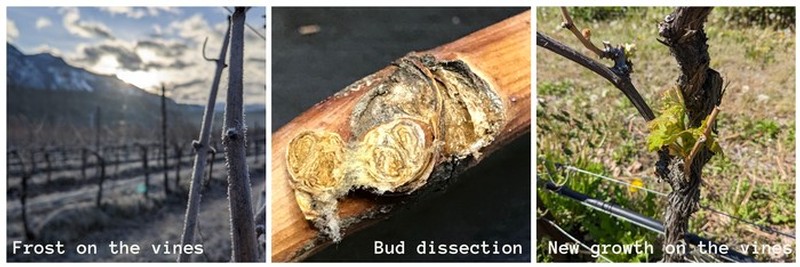2023 Crop Report: A Look at the Impact of the 2022/2023 Winter
You may have read some reports about the past winter cold snap and the effect on vineyards in the Okanagan, where they forecast a very low crop year for 2023. In our Lillooet vineyards, last winter was equally cold and our forecast for 2023 is also for a very low crop.
Last winter we had a record low temperature of minus 26.4 degrees C on Dec. 22nd. Cold temperatures are not the only thing that affect our cropping levels. The year before we had a low of minus 25.7 degrees C in our vineyard on Boxing Day, which was close. Still, we had an amazing crop in 2022, both in quantity (average crop) as well as in quality. But the circumstances were very different then.
In the 2021/2022 winter, we had over 1 foot of snow in our vineyard in December and from early December onward, the temperatures started dropping gradually beyond zero degrees. Vines can adapt to colder temperatures if they have time to do it, and in that winter, they adapted very nicely to the winter circumstances. The snow gave a nice layer of insulation, and the soil was relatively warm as a result.
In the winter of 2022/2023, there was almost no snow cover to keep the soils warm and the temperatures oscillated between Nov.25th (+13 degrees C) and Dec.1st (-19 degrees C) and then again between Dec. 12th (+3.5 degrees C) and Dec 22nd (-26.4 degrees C). This all came after the warmest October on record in our vineyards, with temperatures in the high and mid-twenties until mid-October.
Such varying circumstances make it harder for vines to adapt to low temperatures and the result is that some parts of the vines die back, especially the buds that carry the potential crop for the next season.
Each year, our vineyard manager Chris does tests to estimate our potential crop. He takes canes from our different vineyard blocks, then he dissects the buds on those canes to see if they are alive (=green).
A grapevine’s bud consists of 3-buds-in-1. The primary bud is generally the most fruitful, the secondary a bit less, and generally, the tertiary bud is the hardiest, but the least fruitful which means that it may not produce any fruit, but just ensures that the plant can grow that season. The primary bud is usually the most susceptible to frost damage. By sampling the buds, we can estimate what the rest of the buds will be like.
The results of this test can differ from block to block and from variety to variety. Typically, we see some degree of bud damage in some blocks, and typically that damage is within a certain range. Chris then instructs our vineyard team, when pruning, to leave more buds on vines in the blocks that showed bud damage. The extra buds that are left will compensate for the number of dead buds. That way we can make sure that our potential crop level will be high enough.
This year, the bud tests showed severe die-back of primary buds in most blocks, way outside of that acceptable range. There are more damaged buds than what we can compensate for by leaving more buds on the vines. As a test, Chris left 10 rows in our Merlot block un-pruned until later. We will not prune these vines until we can see the new shoots on the vines.
We’ve noticed that our Merlot showed the highest rate of bud damage, while the Pinots were looking better. Overall, we are seeing a much higher rate of bud damage than we’ve seen in prior years. At this time of the year, it is too early to tell what the exact cropping levels will be, but we are sure that they will be under our average cropping levels.
In the Okanagan, similar bud tests have been done in the vineyards, with similar results.
At the end of May/early June, we will have a better idea of how many grape clusters we can expect. Our vineyard crew will have to work extra hard this year to keep our vines and grapes healthy and to carefully manage our reduced crop. Lower crop levels typically result in higher quality fruit, and therefore in higher quality wines, but in smaller quantities.
It will not be until harvest that we know how much crop we will have to work with, and we will keep you posted if we have any news from our vineyard this summer.


